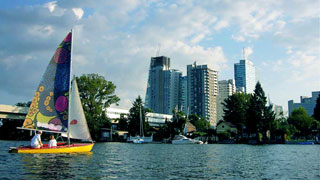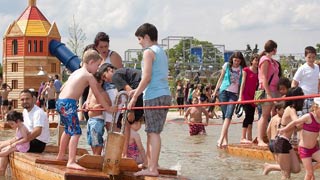Tempting "blue gold"
Embark on a trip to Vienna's water worlds. Idyllic landscapes with crystal clear water are the right destination for exciting excursions.
Enjoy the water, go on a pedal boat ride or sail away

Sailing is one of the most popular leisure activities on the shores of the Old Danube.
The Old Danube and the recreational area Lobau attract millions of visitors every year with large lush green space and divine water. The numerous stops of the "First Vienna Spring Water Main Hiking Trail" are devoted to the history of this landscape, covering a wide range of topics such as the development from the non-regulated Danube river to the urban oasis or the ecological significance of intact nature. The 17 kilometre-long circular route starts with a waterside promenade along the lower stretch of the Old Danube, continues along Mühlwasser and Alte Naufahrt through the foreland of Lobau to the Danube Wetlands National Park, which offers wonderful walking and biking trails. Bathing, pedal boat rides or even sailing are some of the most popular leisure activities on the shores of the Old Danube. Thanks to their proximity to the city centre and good transport links (underground lines U1 and U6), the "river beach facilities" along the Old Danube are an attractive leisure and bathing spots. Lobau is recommended for devotees of nudism, where the first nudist beaches emerged as early as in the 1920s.
Hiking along the Spring Water Main Mains
Vienna's two Spring Water Mains ensure that the city does not only have water for bathing. We may fill our glasses with top-quality tap water travelling 36 hours from the mounting springs in the Limestone Alps in Styria and Lower Austria to Vienna. The force of gravity produced by the down-slope movement of the water along this route is even used for electricity generation. To mark the 125th anniversary of Vienna's First Vienna Spring Water Main in 1998, a hiking trail was established along its most beautiful sections, the so-called "First Vienna Spring Water Main Hiking Trail". The two sections of the hiking trail in close proximity to Vienna have been conceived as one-day hiking tours. Within easy reach of public transport lines and suitable for every hiker, the first section runs from Bad Vöslau to Mödling. The second part of the hiking trail starts at the Kaiserbrunn Water Main Museum and ends in Gloggnitz on the foothills of Semmering.
Potable water supply from the ancient Romans to the present
In 1861 the go-ahead for the construction of Spring Water Main was given with the "Memorandum of the Vienna Office of Urban Construction on studies about a suitable water supply system for Vienna" ("Denkschrift des Wiener Stadtbauamtes über die Studien zu einer geeigneten Wasserversorgung Wiens"). The supply of urban areas with quality potable water is and has been a vital task. Settlers from ancient Rome had already channelled mountain spring water from the region south of Vienna to the legionary camp Vindobona. The use of independent wells to supply the population with potable water in the Middle Ages was a big step backwards. The first urban water supply system – the "Water Pipeline of Hernals" – was established after the great fire in 1525 due to the insufficient supply with fire-fighting water. Water from public wells was distributed by "water-sellers". Emperor Charles VI. had water brought in tubs from Kaiserbrunn by "water riders". Visitors of the "HochQuellenWasser Museum" in the mountain region "Wildalpen" as well as the Water Pipeline Museums of Kaiserbrunn and Wildalpen learn about these facts and many other details, e.g. the management of water protection areas or the journey of water from the mountain spring to the large city.
"Blue gold" and quality of life
In the middle of the 19th century each of the 326,000 inhabitants of Vienna used only four to five litres of water per day. This inadequate water supply led to typhus and cholera epidemics. Thanks to the stamina and determination of geologist and politician Eduard Sueß, the City of Vienna adopted a decision to build Vienna's First Spring Water Main on 12 July 1864. The rapid increase in the number of inhabitants of Vienna after 1890 made it necessary to open up new water resources. On 2 December 1910 Vienna's Second Spring Water Main was inaugurated. Covering 95 per cent of the annual water consumption of the Viennese citizens, the two water mains make a vital contribution to the excellent quality of life in this city.
Europe's largest water playground

The "Water Tower" aquatic playground is the biggest of its kind in Europe.
The water reservoir tower in the tenth district of Vienna is a relic of the time before the construction of the Second Vienna Spring Water Main. The Aquatic Playground "Water Tower" (Wasserspielplatz Wasserturm) is Europe's largest facility of this type. It was built around the water reservoir tower, which is an outstanding example of the architectural style "Historicism". The unique landscaped amenity area offers relaxation for adults, while water slides, swing bridges, a volleyball court and, last but not least, a "mud zone" allows kids to indulge in fun-filled activities. Children will learn everything about the element water through fun and games. A special adventure path runs from the mountain spring source, past the water reservoir tower, waterfalls and streamlets to various ponds and symbolises the journey of water from the mountains to the densely populated city. Two characters of a booklet, the water drops called "Tim and Trixi Tropf" pursue the mission of informing old and young visitors about the valuable and vital resource water. After taking a class of splashing fun at Vienna Water School (Wiener Wasserschule), the graduates will not only be water lovers but also water experts knowing everything about hydrological cycles, the functions of woods, the use of water or water pollution.
Refurbished drinking fountains
The spring cleaning of the about 900 fountains in Vienna is finished. The Giant Fountain (Hochstrahlbrunnen) at Schwarzenbergplatz in the first district became Vienna's first memorial fountain. The spectacle of water and light of changing colours can be admired from dusk to midnight.
The ideal thirst quenchers
Vienna's drinking fountains supply pure mountain spring water to thirsty pedestrians free of charge. They are in great demand, especially on a hot summer day. During the peak season about 12,000 litres per week are consumed from the mobile drinking fountain at Heldenplatz.
wien.gv.at-English Edition
Contact form
